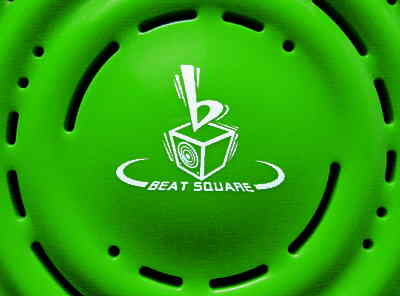
|
 |
|
This Potex toy instrument is one of the most innovative and versatile tekkno toys I found yet, because it has 4 active infrared hand gesture sensors for live play, those basically constitute a toy version of Roland's well known D-Beam controller.
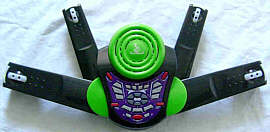 |
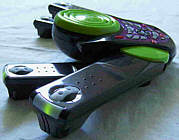 |
Although the patterns and percussion loops are only preset samples, the sensors respond rather coarse (sense only on/off speed information?) and there are various other limitations, this thing is definitely far more flexible than certain stubborn wannabe DJ toy crap (e.g. Beat Blenders); in some modes e.g. you can select here percussion or sound effects individually for each of the 4 sensors, which permits a lot of combinations, thus in future the AIR-Dance Mixer will likely become a similar expensive and wanted classic like Casio Rapman or SK-60. Annoying is that there is always some steady key matrix buzz present, the sensors in use add even more of that buzz and on the lowest volume setting the instrument plays still louder than medium ambient volume.
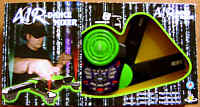 |
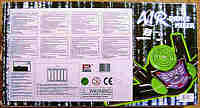 |
 |
 |
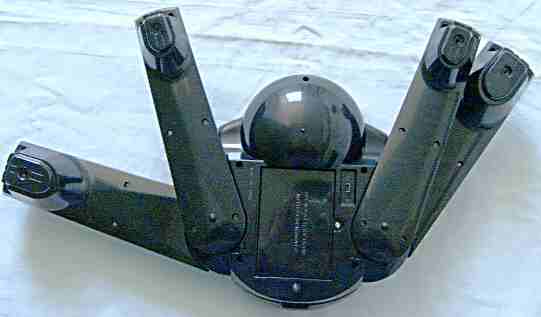
The case itself has no model name (only "Beat Square") and its
design looks less extremely spectacular than other Potex sound toys
(see e.g. Super Jam, Cyber
Keyboard, Mix Me DJ,
Mix
Evolution), but I guess the operation concept is unique enough
to make people stare at it. In the name "AIR-DANCE MIXER" on the box the
word "AIR" is written bigger, thus it may be an abbreviation for "Active
InfraRed"
instead of simply standing for waving the hands in the air. The digital
volume control reduces the bit resolution badly and can not be set really
low; especially some effect sounds always play louder than ambient volume.
The volume and tempo +/- buttons have a 3rd button in the middle for default
setting. The sample resolution is only low to medium and thus not very
clear, but for tekkno this is quite ok. The digital volume control even
reduces the bit resolution further, which may be usable as a sound effect.
Like Mix Me DJ and Mix Evolution also this one has an AUX/CD
input jack with volume knob (hidden at the right side). The speaker is
not that bad, but sounds harsher than my Mix Me DJ. 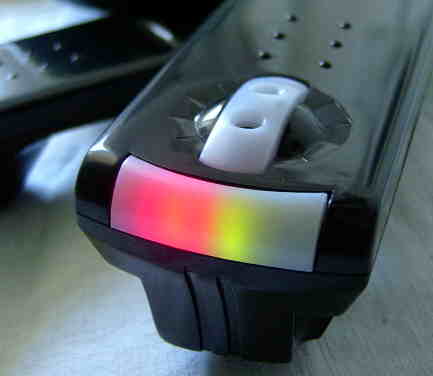 The
outer 2 of the 4 sensor arms are movable; the infrared sensors are active
(with each an IR emitting LED + sensor) and sense hands only in a short
distance of about 10cm, but crosstalking key matrix buzz in the speaker
hints that it recognized the hand already a few cm earlier before the red
LED goes on; a slightly too far hand makes the LED flicker (possibly a
side effect caused by mains hum). The instrument responds on sensor inputs
always with about 0.5s delay, which can be confusing and was likely implemented
to recognize the pattern change gestures (wiping over all 4 sensors). Unlike
most modern sound toys, here fortunately the buttons neither beep nor play
other noises, which makes it well suited for life play. Although there
is no sound output jack, IMO this thing is already a bit more than just
a toy. The feeling of this instrument even somewhat resembles my homemade
Tekknetion
prototype 1. Unfortunately there is always a dose of continuously
buzzing key matrix noise present, which even turns louder when the green
LEDs switch off (but this may be also usable as a tekkno sound effect).
Like
Mix Me DJ there is no power off mode but only a suspend mode
in that any button press immediately powers the instrument on again; the
Potex- typical demo/ play switch at the case bottom only switches the auto
power-off time between 30s and 3min. (I haven't examined the hardware yet.) The
outer 2 of the 4 sensor arms are movable; the infrared sensors are active
(with each an IR emitting LED + sensor) and sense hands only in a short
distance of about 10cm, but crosstalking key matrix buzz in the speaker
hints that it recognized the hand already a few cm earlier before the red
LED goes on; a slightly too far hand makes the LED flicker (possibly a
side effect caused by mains hum). The instrument responds on sensor inputs
always with about 0.5s delay, which can be confusing and was likely implemented
to recognize the pattern change gestures (wiping over all 4 sensors). Unlike
most modern sound toys, here fortunately the buttons neither beep nor play
other noises, which makes it well suited for life play. Although there
is no sound output jack, IMO this thing is already a bit more than just
a toy. The feeling of this instrument even somewhat resembles my homemade
Tekknetion
prototype 1. Unfortunately there is always a dose of continuously
buzzing key matrix noise present, which even turns louder when the green
LEDs switch off (but this may be also usable as a tekkno sound effect).
Like
Mix Me DJ there is no power off mode but only a suspend mode
in that any button press immediately powers the instrument on again; the
Potex- typical demo/ play switch at the case bottom only switches the auto
power-off time between 30s and 3min. (I haven't examined the hardware yet.) |
The sensors function like active infrared light barriers and seem to employ pulsed IR light signals to filter out interferences. (Pulsed signals always tend to have measurable biological effects, but unlike with pulsed EM radiation form mobile phones I don't think that exposure to this fast pulsed light beam is really harmful, so long it does not continuously shine at you during sleep.) Unlike Roland's D-Beam these AIR sensors respond rather coarse and likely only sense on/ off instead of responding to gradual analogue signal changes. However the instrument can recognize some gradual hand motion, but I think it works rather like the velocity sensor of cheap MIDI keyboards, those only measures the time between key up and key down. The same way this sensor likely only recognizes the duration between hand over sensor and hand gone. The sensor usually only triggers a sound event when the hand is taken away (i.e. red LED goes off) and not when it appears in the beam (light goes on). But also a kind of timeout seems to trigger it. The longer the hand stays there, the more intense is event (e.g. pitch goes lower). Generally it takes about 0.5s delay before something happens, which can be confusing, but retriggering the event by further hand motions seem to be a bit faster. When the hand is barely in the detection range, the red LED flickers with about 10Hz, which also modulates the controlled effect and thus e.g. makes the volume stutter or pitch flutter in interesting ways.
The behaviour of the instrument depends on the selected mode. In all modes the "rhythms" can be immediately (re-)started with their 6 OBS buttons and controlled with the play, pause and stop button. The sensors are named from left to right {A, B, C, D}.
sound effect mode: (mode 1)The demo button simply starts "rhythm 1" from mode 1 with medium volume.Wiping right (over all 4 sensors) starts or selects the next preset "rhythm" (loop sample pattern), wiping left starts or selects the previous one. The tempo control changes the sample playback frequency of the loop. Each sensor plays an effect sound sample; slower hand motion bends the pitch down. The "sensor effect" button of each sensor makes it cycles through 3 effect samples (each sensor has a different set).
accompaniments ("rhythms"):
sensor effect preset sounds:
- tekkno with drumroll
- slow tekkno rhythm (grainy computer sound, dull base)
- slow blues piano (with picked bass)
- disharmonic samba (with vibraphone, brass)
- latin (with steel drum?, badly looped)
- funk (e-guitar, e-bass, hammond chord)
sensor A = {long fast scratch, low howling slap bass, high ring + whistling up}rhythm mode: (mode 2)
sensor B = {"ya!", half whispered "rock!", snare or shot + fret noise?}
sensor C = {robot voice "stop!", fast bubbling vocoder "one two"(??), hihat with reverb}
sensor D = {long scratch, electronic blip + scratch noises, half whispered "da house!"}Wiping right starts or toggles the variation of the selected preset "rhythm" (loop sample pattern); each pattern has 2 variations here. Wiping left stops that rhythm with an ending pattern. The tempo control changes the sample playback frequency of the loop. Sensor A and D play an effect sample (fixed, depending on the selected "rhythm"); slower hand motion bends its pitch down. Sensor B changes the master volume (hand down is lower), taking the hand away always sets the volume to default (quite loud, not the previous setting). Making the hand hover in LED flicker distance makes the volume stutter in interesting ways. Sensor C changes the tempo setting (hand down is lower), taking the hand away always sets it to default (not the previous setting). Making the hand hover in LED flicker distance makes the pitch flutter in interesting ways.
accompaniments ("rhythms"):
jam mode: (mode 3)
- fast house, dto. (with organ major chord)
sensor A = horse gallop + picked bass | sensor D = rattle- sort of hard rock, eurobeat? (grunting e-bass tone, funk bass rhythm latin percussion | harmonic minor chord, e-bass, drumkit)
sensor A = brrt, scratch | sensor D = gong scratch- slow fusion, dto. more disharmonic (e-bass, Hammond organ, drumkit)
sensor A = bright scratch staccato | sensor D = orchestra hit low, high- boogie woogie, dto. (piano, e-bass, drumkit)
sensor A = base drum MG staccato, 2 fat zaps | sensor D = high scratch- house pop, dto. (e-organ minor chord, e-bass, drumkit, accompaniment like groovy samba pattern)
sensor A = 2 scratches | sensor D = "heeyoh!"- slow fusion/ ambient, dto. (e-bass, synth pad major chord)
sensor A = scratch rhythm | sensor D = whispered "oh do not that" with echoWiping right (re-)starts the rhythm; wiping left stops it with an ending pattern. Unlike previous modes here the tempo control indeed controls the speed of a rhythm pattern (without pitch change). After wiping right, the rhythm always starts with a dedicated start pattern that repeats until a sensor is used; then the normal rhythm starts with all tracks enabled. Each sensor now mutes or enabled the corresponding instrument track for realtime play.
These are the track names in the manual:
sensor A = Base Beat pattern
sensor B = Guitar 1
sensor C = Guitar 2
sensor D = Sound Effect.The "sensor effect" buttons insert a semi- random fill-in on the corresponding track (not mentioned in the manual).
rhythms:
drum mode: (mode 4)
- funk (drums with distorted tekkno base, short lead guitar loop, thin e-bass(?), funky slapbass)
- heavy metal fusion (hiphop beat, heavy metal e-guitar loop, thin e-bass(?), buzzing slapbass + gong(?))
- funk (fast hiphop beat with cymbal, scratchy funk e-guitar, thin e-bass(?), scratched ricochet staccato sound?)
- punk rock (fast rock rhythm with cymbal, scratchy e-guitar siren, thin e-bass(?), staccato slapbass + zap)
- speed tekkno (fast hammering machine + drums, thin e-bass(?), thin heavy metal e-guitar loop, hissy scratch)
- fast punk rock (distorted hiphop beat with loud snare, thin e-bass & thin scratchy e-guitar, dto., high scratch zap noise)
This mode resembles mode 4, but here wiping left or right only plays each an effect sample. After a rhythm is started (through control panel buttons) each sensor mutes or enabled the corresponding monophonic percussion track for realtime play. The special feature is here that the sound for each of the 4 rhythm tracks can be selected from 12 preset sounds by pressing the corresponding "sensor effect" button (which cycles through them). Beside normal percussion also some electronic tekkno rhythm noises are available. Unfortunately there are no OBS controls to select these sounds but only a single button that steps through them without visual feedback, which makes the use contra- intuitive and a little random. The tempo control changes the rhythm tempo.
rhythms:
preset sounds: {close hihat, tambourin?, cymbal, dull sweep toot, snare, thin buzz (slapbass?), hihat with reverb, analogue snare, fat synth base, open hihat, bongo, tekkno base}
- fast tekkno beat
- fast tekkno beat with beep rhythm
- hammering tekkno drumkit rhythm with bass buzz
- rock rhythm
- slow hardrock
- tekkno beat with phasing
Other toy instruments with IR sensors for gesture control are ToyQuest's
quite
big and expensive Blue Man Group
- Keyboard Experience and Blue Man Group - Percussion Tubes
(both with very stylish white pipeline tube design and iPod drawer
- names after the famous experimental rock and stage performance art band
Blue Man Group).
| removal of these screws voids warranty... | ||
 |
||
|
|